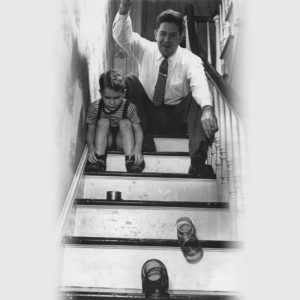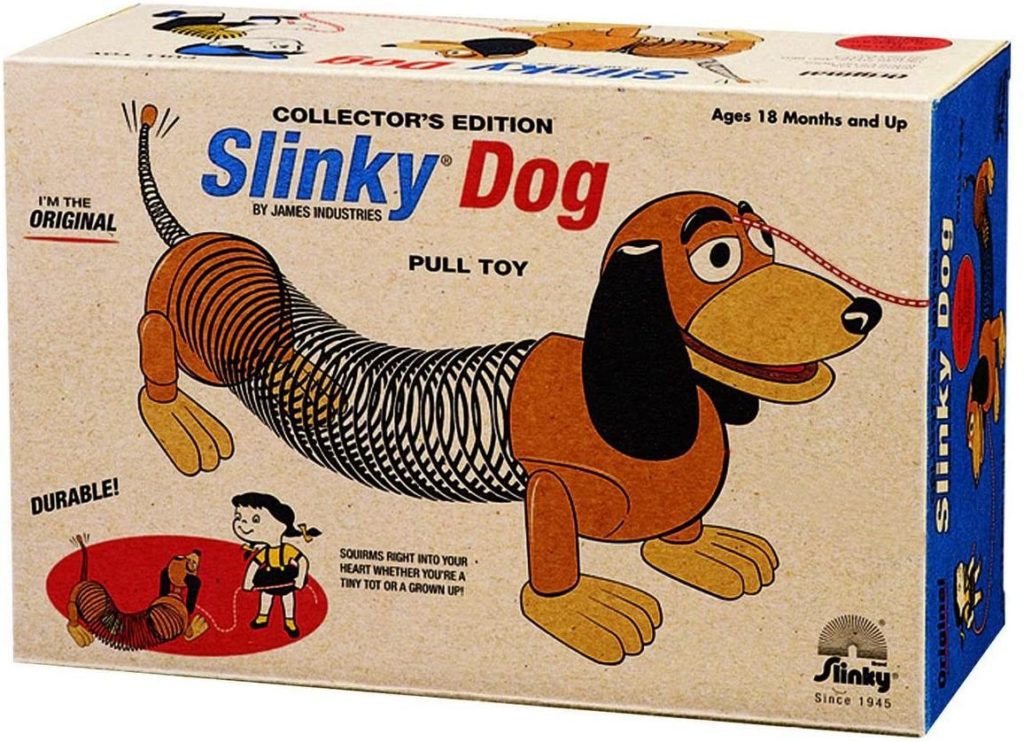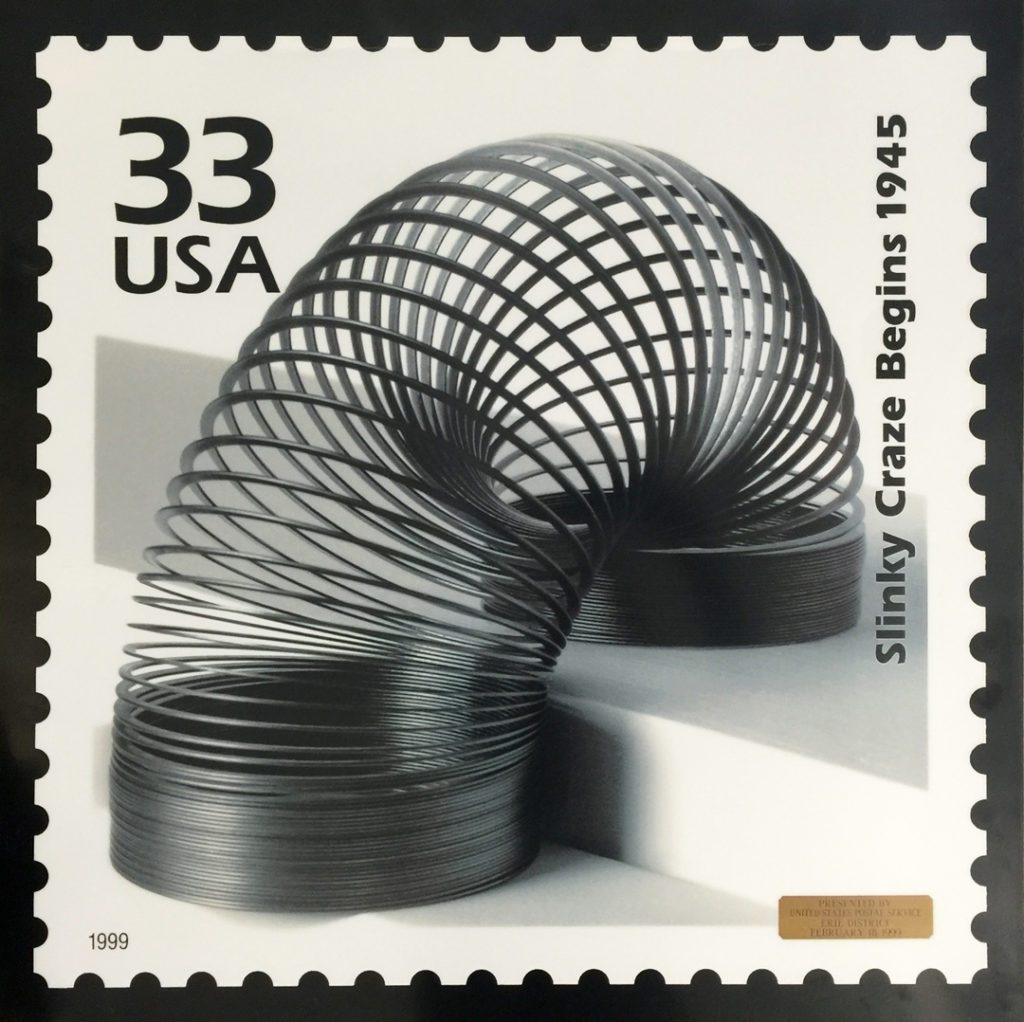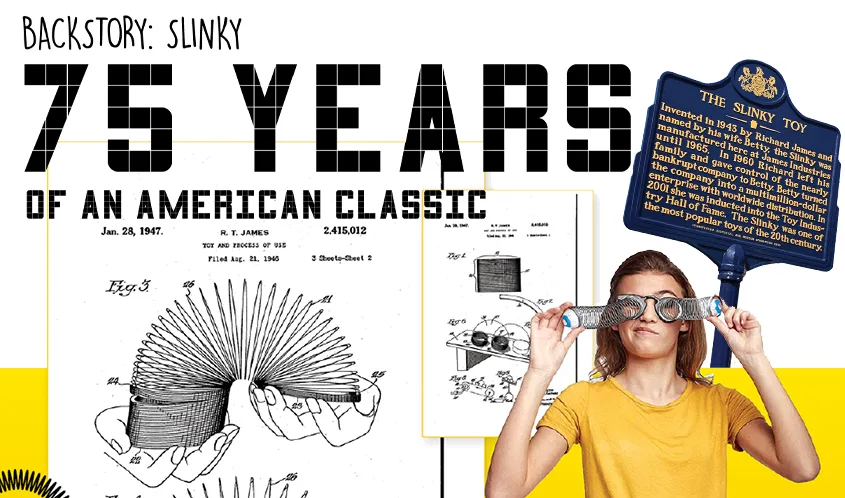Originally published August 17, 2020
Some of the greatest toys of all time have been created completely by accident. Play-Doh, Silly Putty, Etch-A-Sketch, and Silly String are among a group of classic, iconic toys whose roots are tied to other intended purposes, such as a wall cleaner or a spray-on cast.
Another toy, Slinky, was born out of a mishap in 1943 when mechanical engineer Richard T. James was experimenting with tension coils in an effort to stabilize naval instruments. James dropped a coil and watched in amazement as it began to “walk.”
Two years later, James and his wife Betty used a $500 investment to start what later became James Industries. Slinky — named from a Swedish word that Betty discovered in a dictionary — was formally launched in 1945. The incredible “walking” spring was produced using a machine that James invented to flatten 80 feet of steel wire into the 2.5-inch coil that generations of kids and families have known and loved for the past 75 years.

An early example of selling toys by using live product demonstration, the first batch of Slinky toys sold out almost immediately upon making its debut at the Gimbels Department Store in Philadelphia during the holiday season.
In 1947, James received a patent on the original Slinky, a toy that on the surface is incredibly simple, but in reality, is a surprisingly complex result of physics and frequencies working together. In the filing with the U.S. Patent Office, James described Slinky as “a helical spring toy which will transfer its turns from one end to the other in an entertaining manner when it is bent into [a] general semi-circular form and the ends are moved up and down.”
“Growing up, I lived in a one-story home, but we had stairs going down to the finished recreation room in the basement, which were perfect for playing with Slinky,” says toy inventor Michael Dox, owner and principal at ToyArts, a design firm serving the toy industry. “I just remember trying to get the Slinky to walk down as many steps as possible and running down the steps to retrieve it and then climbing back up the steps to try again and again and again.”
By the early 1950s, James Industries saw the potential for Slinky beyond its traditional form and began creating line extensions and additional products, perhaps most notably — and still available — the Slinky Dog. The company then became a licensing pioneer as it licensed its patent to other companies that further expanded on the idea of what the famed coil could do and what toys it could be used for.

The Wilkening Manufacturing Co. of Philadelphia and Toronto soon issued Mr. Wiggle — the same, traditional Slinky, but repackaged in a new box that was sold primarily in Canada. Additional products included Mr. Wiggle’s Cat-A-Puller, Cowboy, Fire Engine, and Frog.
As the space race took off, Slinky introduced the Slinky Satellite Beanie, a tin hat with a Slinky strapped to the top and adorned with a tiny, Sputnik-style satellite toy. By the ‘70s, there were plastic Slinkies, pull-toy Slinkies, and more. The brand was everywhere and even had a catchy jingle that kids and parents still sing today.
In a 1995 interview with the Associated Press, Betty James credited the low cost and simple action of the toy for its lasting appeal.
“I think really it’s the simplicity of it — there’s nothing to wind up; it doesn’t take batteries,” she said. “I think also the price helps. More children can play with it than a $40 or $60 toy.”

Dox, who worked to create the character-based Slinky Headz for Alex Brands last year, cites the distinctive sound of the coils as part of the appeal, but that’s not all.
“I think the No. 1 quality that makes the Slinky so appealing for kids is the feel of it,” Dox says. “If you never picked one up and just saw it in a box on the toy store shelf, it is not very exciting. Once you pick one up and glide it from hand to hand, it just feels cool as the momentum carries it from side to side.”
Like most brands that have been able to stand the tests of time, Slinky hasn’t always traveled a smooth road, and the corporate lineage has been filled with bumps and bruises along the way.

Amid divorce, Betty James took the helm of the original company in 1960 and brought it back from the brink of bankruptcy. She moved production to Hollidaysburg, Penn., and built it into a multimillion-dollar empire. Slinky was inducted into the National Toy Hall of Fame in 2000, and James herself was inducted into the Toy Industry Hall of Fame the following year.
In the late 1990s, Slinky was sold to Michigan-based Poof Products and later merged to create Poof-Slinky. That entity later became a part of Alex Brands, which suddenly shut its doors following Toy Fair New York this February, just days after announcing a 75th anniversary celebration for Slinky.
With its future in limbo, Just Play Products stepped in to acquire Slinky and another American toy, Shrinky Dinks, from the auction of Alex Brands’ assets in May.
“For 75 years, Slinky has been one of the most popular and recognizable playthings around the world,” says Charlie Emby, co-president of Just Play and The Toy Association board member. “We look forward to bringing this cherished product, along with the popular Shrinky Dinks, to new generations of kids.”
On Aug. 30, National Slinky Day, Just Play will formally launch the 75th Anniversary Slinky collection. The company plans to honor the legacy of the American-made toy by continuing the milestone anniversary celebration with a triumphant return to Toy Fair New York next February.

In the meantime, the factory in Hollidaysburg is open again and churning out new Slinkies under Just Play, including the Original Slinky, Retro Slinky, Collector’s Edition Black Metal Slinky, the colorful Plastic Slinky, and Plastic Slinky Jr.
This article was originally published in the July/August 2020 edition of the Toy Book. Click here to read the full issue!

